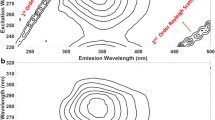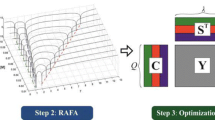Abstract
Multiple emitting components in a fluorophoric system often produce complicated emission spectra. Extracting the individual spectral information from the composite spectra is important in order to comprehend the photophysical processes occurring in the multifluorophoric systems. Although the combination of Principal Component Analysis and Multivariate Curve Resolution-Alternate Least Square (PCA/MCR-ALS) technique is a well-known approach for curve deconvolution, its applicability in the spectral deconvolution of vibronically and electronically mixed up emitting systems as well as systems merged up with multiple electronic bands without a priori knowledge of the individual emitting species, is not properly studied. The present work highlights the strength of PCA/MCR-ALS in retrieving pure spectral information from the set of complex spectra arising out of the regular variation of causative factors that result in the variation of spectral composition. The retrieval of the emission bands utilizing the PCA/MCR-ALS technique has been made without having a priori information of the emitting species present in the multifluorophoric systems and the resolved spectra correspond well with the fluorescence spectra of the individual chemical species. The common curve fitting methods such as Gaussian and Lorentzian techniques have been found to be unsuccessful in providing meaningful photophysical information through the retrieved spectra. A comparative study of the curve fitting techniques MCR-ALS, Gaussian and Lorentzian in a set of complicated emission spectra of (i) pyrene and its excimer, (ii) pyrene and its excimer in presence of benzo[a]pyrene, and (iii) fisetin in bile salt medium is presented herein in details.














Similar content being viewed by others
References
Caarls W, Celej MS, Demchenko AP, Jovin TM (2010) Characterization of coupled ground state and excited state equilibria by fluorescence spectral deconvolution. J Fluoresc 20:181–190
Meier RJ (2005) On art and science in curve-fitting vibrational spectra. Vib Spectrosc 39:266–269
Blass WE (1981) Deconvolution of absorption spectra. University of Tennessee, Academic Press Inc., New York
Pierce JA, Jackson RS, Van Every KW, Griffiths PR (1990) Combined deconvolution and curve fitting for quantitative analysis of unresolved spectral bands. Anal Chem 62:477–484
Friesen WI, Michailian KH (1991) Deconvolution and curve-fitting in the analysis of complex spectra: the C-H stretching region in infrared spectra of coal. Appl Spectrosc 45: 50–56
Chen X, Lai Y, Chen X, Shi Y, Zhu D (2016) A novel spectral multivariate calibration approach based on a multiple fitting method. Analyst 141:5759–5766
Meira M, Quintella CM, Ribeiro EM de O, Silva WL (2015) Gaussian fit to the fluorescence spectra for determination of adulteration to diesel by addition of residual oil. Biomass Conv Bioref 5: 295–297
Lancaster P, Šalkauskas K (1986) Curve and surface fitting: an introduction. Academic Press, London
George SM, Harris AL, Berg M, Harries CB (1984) Picosecond studies of the temperature dependence of homogeneous and inhomogeneous vibrational line width broadening in liquid acetonitrile. J Chem Phys 80:83–94
Myers AB, Trulson MO, Mathies RA (1985) Quantification of homogeneous and inhomogeneous broadening mechanisms in trans-stilbene using absolute resonance Raman intensities. J Chem Phys 83:5000–5006
Wertheim GK, Butler MA, West KW, Buchanan DNE (1974) Determination of the Gaussian and Lorentzian content of experimental line shapes. Rev Sci Instrum 45:1369–1371
Lerner PB, Chadwick MB, Sokolov IM (1993) Inhomogeneous broadening of electronic transitions in liquid helium bubble: the role of shape fluctuations. J Chem Phys 90:319–330
Maddams WF (1980) The scope and limitations of curve fitting. Appl Spectrosc 34: 245–267
Koenig MF, Grant JT (1986) Comparison of factor analysis and curve-fitting for data analysis in XPS. J Electron Spectrosc 41:145–156
Tauler R (1995) Multivariate curve resolution applied to second order data. Chemom Intell Lab Syst 30: 133–146
Tauler R (2001) Calculation of maximum and minimum band boundaries of feasible solutions for species profiles obtained by multivariate curve resolution. J Chemom 15: 627–646
Tauler R, Kowalski B, Fleming S (1993) Multivariate curve resolution applied to spectral data from multiple runs of an industrial process. Anal Chem 65:2040–2047
Azzouz T, Tauler R (2008) Application of multivariate curve resolution alternating least squares (MCR-ALS) to the quantitative analysis of pharmaceutical and agricultural samples. Talanta 74:1201–1210
de Juan A, Jaumot J, Tauler R (2014) Multivariate Curve Resolution (MCR) solving the mixture analysis problem. Anal Methods 6:4964–4976
Ruckebusch C (2016) Resolving spectral mixtures: with applications from ultrafast time-resolved spectroscopy to super-resolution imaging. 30. Elsevier, Amsterdam
Esteban M, Arinìo C, Díaz-Cruz JM, Díaz-Cruz MS, Tauler R (2000) Multivariate curve resolution with alternating least squares optimization: a soft-modelling approach to metal complexation studies by voltammetric techniques. TrAC Trends Anal Chem 19:49–61
Garrido M, Rius FX, Larrechi MS (2008) Multivariate curve resolution–alternating least squares (MCR-ALS) applied to spectroscopic data from monitoring chemical reactions processes. Anal Bioanal Chem 390:2059–2066
Kumar K, Mishra AK (2012) Application of ‘multivariate curve resolution alternating least square (MCR–ALS)’ analysis to extract pure component synchronous fluorescence spectra at various wavelength offsets from total synchronous fluorescence spectroscopy (TSFS) dataset of dilute aqueous solutions of fluorophores. Chemom Intell Lab 116: 78–86
Simpson JV, Balakrishnan G, JiJi RD (2009) MCR-ALS analysis of two-way UV resonance Raman spectra to resolve discrete protein secondary structural motifs. Analyst 134:138–147
Cieślik-Boczula K, Czarnik-Matusewicz B, Perevozkinab M, Rospenka M (2015) MCR-ALS as an effective tool for monitoring subsequent phase transitions in pure and doped DPPC liposomes. RSC Adv 5:40455–40464
Rebarz M, Kukovec B, Maltsev OV, Ruckebusch C, Hintermann L, Naumov P, Sliwa M (2013) Deciphering the protonation and tautomeric equilibria of firefly oxyluciferin by molecular engineering and multivariate curve resolution. Chem Sci 4: 3803–3809
Ghose A, Rebarz M, Maltsev OV, Hintermann L, Ruckebusch C, Fron E, Hofkens J, Mely Y, Naumov P, Sliwa M, Didier P (2014) Emission properties of oxyluciferin and its derivatives in water: revealing the nature of the emissive species in firefly bioluminescence. J Phys Chem B 119: 2638–2649
Mendieta J, Diaz-Cruz MS, Esteban M, Tauler R (1998) Multivariate curve resolution: a possible tool in the detection of intermediate structures in protein folding. Biophys J 74:2876–2888
Wise BM, Gallagher NB, Shaver JM, Windig W, Koch RS, Bro R (2006) PLS_Toolbox 4.0 Eigen vector research. The Math Works, Natick
Birks JB, Christophorou LG (1968) Excimer fluorescence spectra of pyrene derivatives. Spectrochim Acta 19: 401–410
Turro NJ, Kuo P (1968) Pyrene excimer formation in micelles of nonionic detergents and of water-soluble polymers. Langmuir 4:438–442
Kalyanasundaram K, Thomas JK (1977) Environmental effects on vibronic band intensities in pyrene monomer fluorescence and their application in studies of micellar system. J Am Chem Soc 99(7): 2039–2044
Turro NJ, Masayuki A, Yekta A (1979) A comparison of intermolecular and intramolecular excimer formation in detergent solutions. Temperature effects and microviscosity measurements. J Am Chem Soc 101(3):772–774
Piñeiro L, Novo M, Al-Soufi W (2014) Fluorescence emission of pyrene in surfactant solutions. Adv Colloid Interf Sci 215: 1–12
Pisarčik M, Devinsky F, Pupak M (2015) Determination of micelle aggregation numbers of alkyltrimethyl ammonium bromide and sodium dodecyl sulfate surfactants using time-resolved fluorescence quenching. De Gruyter Open 13: 922–931
Anachkov SE, Danov KD, Basheva ES, Kralchevsky PA, Ananthapadmanabhan KP (2012) Determination of the aggregation number and charge of ionic surfactant micelles from the stepwise thinning of foam films. Adv Colloid Interf Sci 183–184: 55–67
Olson RW, Fayer MD (1980) Site-dependent vibronic line widths and relaxation in the mixed molecular crystal pentacene in p-terphenyl. J Phys Chem 84:2001–2004
Myers AB (1998) Molecular electronic spectral broadening in liquids and glasses. Annu Rev Phys Chem 49:267–295
Jaumot J, Gargallo R, de Juan A, Jaumot J (2005) A graphical user-friendly interface for MCR-ALS: a new tool for multivariate curve resolution in MATLAB. Chemom Intell Lab Syst 76: 101–110
Nakajima A (1973) Fluorescence lifetime of pyrene in different solvents. Bull Chem Soc Jpn 46: 2602–2604
Subashchandrabose SR, Krishnan K, Gratton E, Megharaj M, Naidu R (2014) Potential of fluorescence imaging techniques to monitor mutagenic PAH uptake by microalga. Environ Sci Technol 48:9152–9160
Selvam S, Mishra AK (2011) Multiple prototropism of fisetin in sodium cholate and related bile salt media. Photochem Photobiol Sci 10:66–75
Banerjee A, Sengupta PK (2006) Encapsulation of 3-hydroxyflavone and fisetin in β-cyclodextrins: excited state proton transfer fluorescence and molecular mechanics studies. Chem Phys Lett 424:379–386
Guharay J, Dennison SM, Sengupta PK (1999) Influence of different environments on the excited-state proton transfer and dual fluorescence of fisetin. Spectrochim Acta Mol Biomol Spectrosc 55: 1091–1099
Falkovskaia E, Sengupta PK, Kasha M (1998) Photophysical induction of dual fluorescence of quercetin and related hydroxyflavones upon intermolecular H-bonding to solvent matrix. Chem Phys Lett 297:109–114
Sytnik A, Gormin D, Kasha M (1994) Interplay between excited-state intramolecular proton transfer and charge transfer in flavonols and their use as protein-binding-site fluorescence probes. Proc Natl Acad Sci 91: 11968–11972
Acknowledgements
Madhumita Tarai is thankful to the Council of Scientific and Industrial Research (CSIR) New Delhi, India for providing a research fellowship. The authors thank CSIR for financial support to carry out the work.
Author information
Authors and Affiliations
Corresponding author
Rights and permissions
About this article
Cite this article
Tarai, M., Mishra, A.K. Application of Multivariate Curve Resolution–Alternate Least Square Technique on Extracting Pure Spectral Components from Multiple Emitting Systems: a Case Study. J Fluoresc 27, 2023–2036 (2017). https://doi.org/10.1007/s10895-017-2141-z
Received:
Accepted:
Published:
Issue Date:
DOI: https://doi.org/10.1007/s10895-017-2141-z




